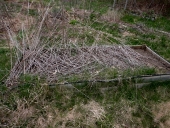




permaculture wiki: www.permies.com/permaculture




permaculture wiki: www.permies.com/permaculture




Lincolnshire Wolds. England. Anaerobic clay, on a SSW facing slope.




permaculture wiki: www.permies.com/permaculture




Lincolnshire Wolds. England. Anaerobic clay, on a SSW facing slope.








Hugh H. wrote:
I use alfalfa, red clover, yarrow, comfrey, etc. in my beds, if you call that a cover crop. When I want more light on my other crops I cut them back and use them as mulch, which also gives a boost of nitrogen into the soil for the N-fixers thanks to rhizodeposition. When there isn't much else growing, I let them take over for a while.
Being perennials they don't seem to mind being given a complete haircut at times, as they grow back happily.
deanom wrote:
My Food Forest is an acre in size, newly planted, and with the grass still intact. I am sowing chicory, and planting mints into areas mulched with grass, cut with a scythe.
The plants that I mentioned earlier are in a vegetable garden, in which i'm experimenting with Bonfils grain growing as part of a standard vegetable rotation. Very early days still, but full of potential.
If you're interested, there is a bit more detail on my blog.
http://deanom.wordpress.com/
Wishing you well
Deano
permaculture wiki: www.permies.com/permaculture








deano Martin wrote:My Food Forest is an acre in size, newly planted, and with the grass still intact. I am sowing chicory, and planting mints into areas mulched with grass, cut with a scythe.
The plants that I mentioned earlier are in a vegetable garden, in which i'm experimenting with Bonfils grain growing as part of a standard vegetable rotation. Very early days still, but full of potential.
If you're interested, there is a bit more detail on my blog.
http://deanom.wordpress.com/
Wishing you well
Deano
 3
3








elisabet skyhawk wrote:
did you choose red clover over white dutch or others for any particular reason? I am planting some clover soon and wondering if there is any difference... and why the others in the mix?.....i'm in the northwest...washington....elisabet




Lincolnshire Wolds. England. Anaerobic clay, on a SSW facing slope.








permaculture wiki: www.permies.com/permaculture

















Paul Cereghino- Ecosystem Guild
Maritime Temperate Coniferous Rainforest - Mild Wet Winter, Dry Summer
 1
1




Our Microgreens: http://www.microortaggi.it
 1
1








andrew john wrote:Yes i am using perennial cover crops.

|
Cats say "meow" because they think that is what people sound like. This tiny ad told me so:
The new kickstarter is now live!
https://www.kickstarter.com/projects/paulwheaton/garden-cards
|






